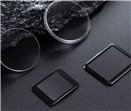

Time:2024-12-30
The term sapphire glass frequently appears in modern technological products, especially on watch mirrors and protective windows of some technological equipment. Due to its hardness and optical properties, it has become a symbol of the pursuit of quality in many products. However, it is precisely its significant advantage of high hardness that brings many challenges and difficulties to processing. This article will explore the hardness characteristics of sapphire glass and the challenges it faces during processing.
Sapphire glass has strong wear resistance and scratch resistance, making it an ideal material for making watch mirrors. Compared to traditional mineral glass or synthetic glass, it has higher hardness and better luminous properties, ensuring that the watch maintains clear and scratch free mirror surface even after prolonged use. In addition, sapphire glass also has excellent properties such as high temperature resistance and chemical corrosion resistance, which enables it to maintain stable performance even in extreme environments.
However, it is precisely this high hardness that brings challenges to its processing. High hardness means that harder tools and abrasives need to be used during the processing. Traditional mechanical processing methods, such as grinding wheel cutting, milling, etc., often struggle when facing sapphire glass because the hardness of these tools is often lower than that of sapphire glass, resulting in low processing efficiency and easy problems such as edge breakage and fragmentation. Therefore, the processing of sapphire usually requires the use of special diamond cutting tools and abrasives, which not only have high hardness, but also have good wear resistance and stability, ensuring the smooth progress of the processing process.

In addition to the selection of tools and abrasives, the brittleness of sapphire glass is also a major challenge during the processing. Due to its unique internal structure, sapphire glass is prone to brittle fracture when subjected to external forces. This type of fracture not only leads to material waste, but may also affect the quality and performance of the product. Therefore, strict control of machining parameters such as cutting speed, feed rate, cutting depth, etc. is required during the machining process to reduce stress concentration and heat accumulation, thereby reducing the risk of brittle fracture. In addition, precise grinding and polishing techniques are required to eliminate small cracks and defects generated during the processing, ensuring the surface quality and optical performance of the final product.
When processing sapphire glass, the wear of processing tools is also an issue that cannot be ignored. Due to its high hardness, tools and abrasives will suffer severe wear during the machining process, which not only increases machining costs but also shortens the tool's lifespan. To solve this problem, special coating techniques are usually used to improve the durability and efficiency of tools. These coating materials typically have high hardness and wear resistance, which can effectively protect the tool surface during processing, reducing wear and damage. At the same time, it is necessary to regularly maintain and replace tools and abrasives to ensure their working condition.
The application of sapphire glass in the fields of electronics and optoelectronics also places higher demands on its processing accuracy. In these fields, high-precision shape and size control is usually required to ensure product performance and reliability. However, due to hardness and brittleness, traditional processing methods are difficult to meet these requirements. Therefore, more precise machining techniques such as laser processing, electrochemical processing, and ultrasonic processing are needed. These technologies not only enable high-precision shape and size control, but also reduce stress and damage generated during the processing, thereby improving product quality and performance.
In addition, the processing cost of sapphire glass is also an important factor restricting its widespread application. Due to the difficulty of processing, the need for special processing methods and equipment, as well as the high consumption of tools and abrasives, the processing cost is usually high. This limits its application in some cost sensitive fields, especially in large-scale production. In order to reduce costs and improve processing efficiency, researchers and engineers are constantly exploring new processing technologies and methods, such as using more efficient diamond cutting tools and abrasives, developing new coating technologies, etc., to improve the processing of sapphire glass.
When processing sapphire glass, it is also necessary to pay attention to the control of the processing environment. Due to sensitivity to changes in temperature and humidity, it is necessary to maintain constant temperature and humidity conditions during the processing to avoid processing errors and defects caused by environmental changes. At the same time, strict cleaning and dust prevention measures need to be taken on the processing site to prevent dust and impurities from affecting the processing process and products.
Although the high hardness of sapphire glass brings many advantages, it also brings many challenges and difficulties to its processing. To overcome these difficulties, it is necessary to adopt special processing techniques and equipment, select appropriate tools and abrasives, strictly control processing parameters and environmental conditions, etc. Only in this way can we ensure that the processing quality and performance of sapphire glass meet the requirements, thereby promoting its application and development in more fields.






Tel
Mobile phone
Customer service
TOP